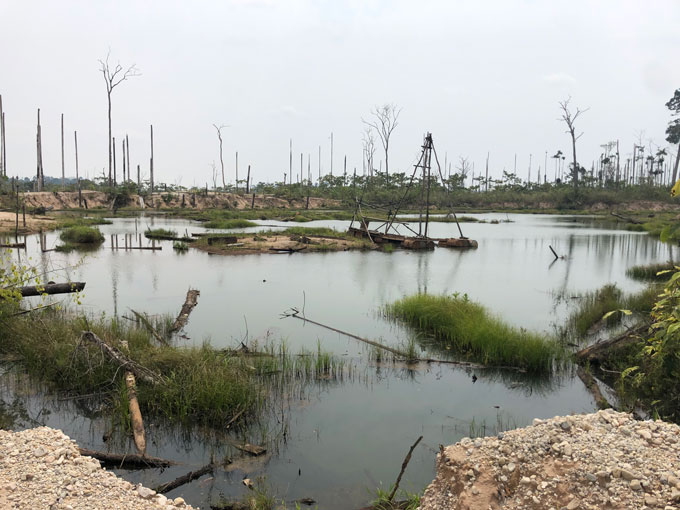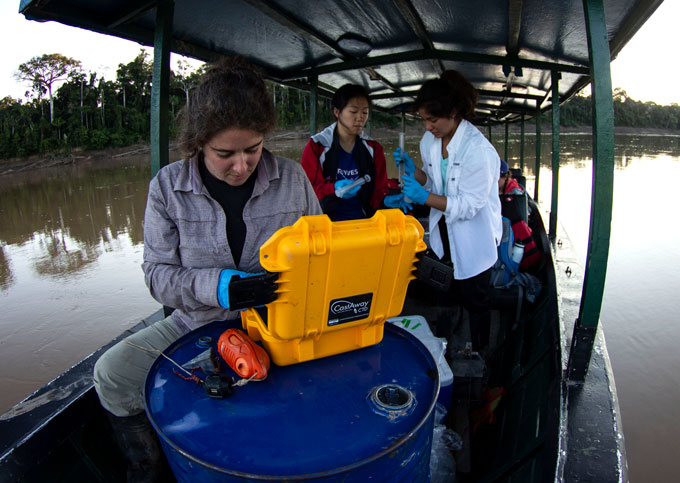One of the richest biodiversity hotspots in the world is Peru’s Madre de Dios, a region of the Amazon located at the base of the Andes Mountains. When biogeochemist Jacqueline Gerson first traveled there in 2017, she found herself on a boat heading downstream through the forest. As she passed the banks of the river, she noticed a change of scenery.
At first, “it was beautiful, old-growth forest, lots of birds, lots of different wildlife,” says Gerson, a Ph.D. student at Duke University at the time. “Then as I continued downstream … you see these rocks first,” she adds. “As you go along, you see clump after clump after clump and then you start to see some deforestation.”
She witnessed signs of small-scale and artisanal gold mining. Unlike large-scale industrial operations with fleets of dump trucks and excavators, workers here use basic tools or their hands to extract ore. These informal gold mining efforts are so prolific in Madre de Dios that they support at least half of the region’s economy.

But there is a price for this gain. Small-scale miners mix mercury into river bank sediments that contain nuggets of gold. This produces a gold-mercury amalgam that can be easily separated from the trash and then burned to isolate the gold. But this burning also emits mercury fumes into the open air.
For Gerson, now at Cornell University, shedding light on how toxic pollutants flow through the environment is a calling. It studies how human activities contribute to these pollutants and change their pathways.
Globally, humans release more than 2,000 metric tons of mercury into the air each year from coal-burning plants, waste incineration facilities, cement production sites, mining operations, and other sources. Artisanal and small-scale gold mining generates more than 35 percent of these mercury emissions, making it the main anthropogenic source.
In the environment, bacteria convert the element into the more toxic methylmercury, which bioaccumulates more easily in wildlife and humans.SN: 19.6.14). Exposure to large amounts of mercury can wreak havoc on the central nervous system, digestive tract and kidneys, leading to seizures, blindness, sleep loss, memory loss, headaches, muscle weakness or even death.
Much of Gerson’s work focuses on mercury, but she has studied the movements of other dangerous pollutants, such as selenium released from coal mining and sulfur released from agriculture. In most cases, Gerson already has a good idea of where the substances are coming from when she begins her investigation. It’s the rest of the story – where they go, where they end up – that she’s looking for.
Before we can better manage and reduce the risks these pollutants pose to humans, she says, “we first need to understand their fate.”
An Amazon hotspot
Even before her first trip to Madre de Dios, Gerson was aware that signs of mercury exposure had been reported in communities upriver from mining areas. Perhaps people were eating mercury-laden fish that had swum upstream, but Gerson wondered if there might be other routes of exposure. So she and colleagues returned to the region collecting samples during the summer of 2018 and the following winter.

Surprisingly, mercury levels in the air correlate with proximity to mines. But the water shed by leaves in the forest canopy, known as runoff, offered a more complicated picture. The denser the canopy, the more concentrated the mercury is in the stream, with the highest levels occurring in a conservation area called the Los Amigos Biological Concession, Gerson and colleagues reported in 2022 in Nature Communications. Falling mercury levels in Los Amigos are “the highest burdens of any place on the globe,” says Gerson. “That was really surprising [to find] in this area … which we think of as one of the most remote areas in the world.”
What set Los Amigos apart was its pristine, old-growth forest. The large leaves in the mature forest canopy act as mercury collectors, providing ample surfaces for airborne mercury to collect, accumulate and later be washed to the ground by rain, Gerson says. “If you have a mining community surrounded by old-growth forests, you’re going to see really high mercury loads here.”
And it wasn’t just the leaves. Mining also contaminated wildlife. Mercury levels in the feathers of three species of songbirds with different diets were on average two to three times higher at Los Amigos than in another old-growth forest located away from the mines. Runoff and shed leaves send mercury to the soil, where the pollutant is methylated by bacteria and consumed by plants and animals, Gerson explains.
“It’s important to get this information out,” says biogeochemist Mae Gustin of the University of Nevada, Reno, who was not involved in the research. The impact is more widespread than people realize, she says. “Everyone [eco]the system is getting contaminated.”
A spark in Senegal
Gerson’s fascination with mercury did not begin in the Amazon, but rather dates back to a trip to central Senegal. After receiving her undergraduate degree at Colgate University in Hamilton, NY, she went to Senegal as a Peace Corps volunteer.
There, Gerson met another Peace Corps volunteer who had been living in the Kédougou region, a full day’s drive away in southeastern Senegal. “I remember her talking about the need to change communities because [the] The Peace Corps was concerned about her personal exposure to mercury from mining operations there, Gerson says. “It really piqued my interest.”
With Mercury on her mind, Gerson returned to New York and began a master’s program at Syracuse University in 2014. Her master’s advisor, Charles Driscoll, gave her “tremendous flexibility to choose what I wanted to do for my thesis,” Gerson recalls. Over the next several years, she would publish some of her earliest work on how mercury and methylmercury patterns evolved over a decade in a remote area of the Adirondack Mountains, launching a career in search of quicksilver. .
Research eventually drew Gerson back to Senegal. For a study reported in 2023 in Papers of purest productionshe and colleagues worked with local community members—more than 80 percent of whom identified as miners—to spread awareness of the dangers of mercury. The team also distributed locally made devices called retorts that mitigate miners’ exposure to mercury fumes. Surveys showed that the work helped: The share of respondents who reported that they believed mercury was dangerous increased from 83 to 94 percent, and the percentage of individuals who used replicas at least sometimes increased from 3 to 64 percent.
In the United States, polluter movements aren’t the only avenues Gerson is drawing attention to. It is also dedicated to enlightening science entrants. As a Ph.D. student, she co-founded GALS, a free summer science program that organizes overnight camps and backpacking trips for high school girls and gender non-conforming students. And she wrote a 2023 article on Bulletin of the Ecological Society of America entitled “Demystifying the Graduate School Application Process”.
“There’s a lot of hidden agendas going into high school and going into the sciences in general,” Gerson says, that aren’t easily accessible to those who don’t already know the process. “I’m really passionate about trying to make STEM much more inclusive and helping people find their way as well.”
#biogeochemist #movements #toxic #mercury #pollution
Image Source : www.sciencenews.org